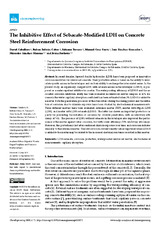The Inhibitive Effect of Sebacate-Modified LDH on Concrete Steel Reinforcement Corrosion
Autor
Caballero, David
Beltrán Cobos, Rubén
Tavares, Fabiano
Cruz-Yusta, M.
Sánchez Granados, Luis
Sánchez Moreno, Mercedes
Pavlovic, I.
Editor
MDPIFecha
2022Materia
LDH-sebacateCorrosion protection
Waterproofed reinforced mortar
Electrochemical measurements
Capillary absorption
METS:
Mostrar el registro METSPREMIS:
Mostrar el registro PREMISMetadatos
Mostrar el registro completo del ítemResumen
In recent decades, layered double hydroxides (LDH) have been proposed as innovative corrosion inhibitors for reinforced concrete. Their protective action is based on the ability to intercalate specific anions in the interlayer and on their ability to exchange the intercalated anion. In the present study, an organically charged LDH, with sebacate anions in the interlayer (LDH-S), is proposed as a water-repellent additive for mortar. The waterproofing efficiency of LDH-S and the associated corrosion inhibition ability has been evaluated in reinforced mortar samples. A 42% decrease in the water capillary absorption coefficient has been estimated when 3% LHD-S is added to a mortar. Both the passivation processes of the steel rebars during the curing period and the initiation of corrosion due to chloride exposure have been studied by electrochemical measurements. Three different mortars have been evaluated: reference mortar (REF), mortar with Mg-Al LDH (LDH), and mortar with LDH-sebacate (LDH-S). The latter has shown an important protective capacity for preventing the initiation of corrosion by chloride penetration, with an inhibitory efficiency of 74%. The presence of LDHs without sebacate in the interlayer also improved the performance of the mortar against rebar corrosion, but with lower efficiency (23% inhibitory efficiency). However, this protection is lost after continued chloride exposure over time, and corrosion initiates similarly to the reference mortar. The low corrosion current density values registered when LDH-S is added to the mortar may be related to the increased electrical resistance recorded in this mortar.

